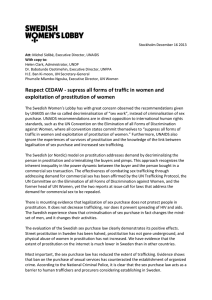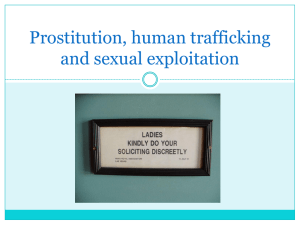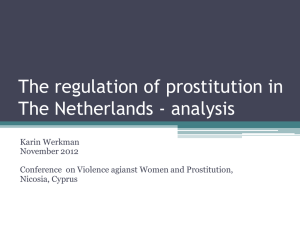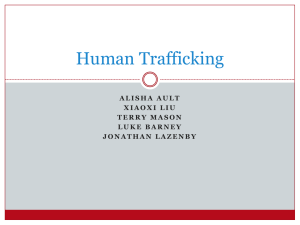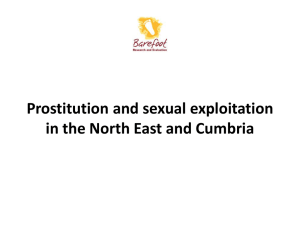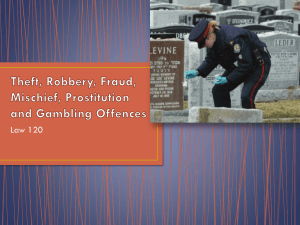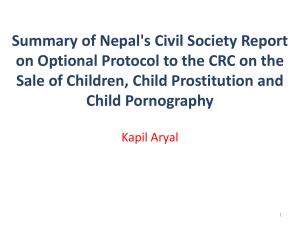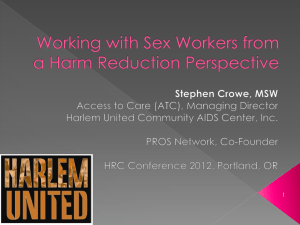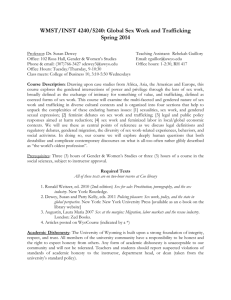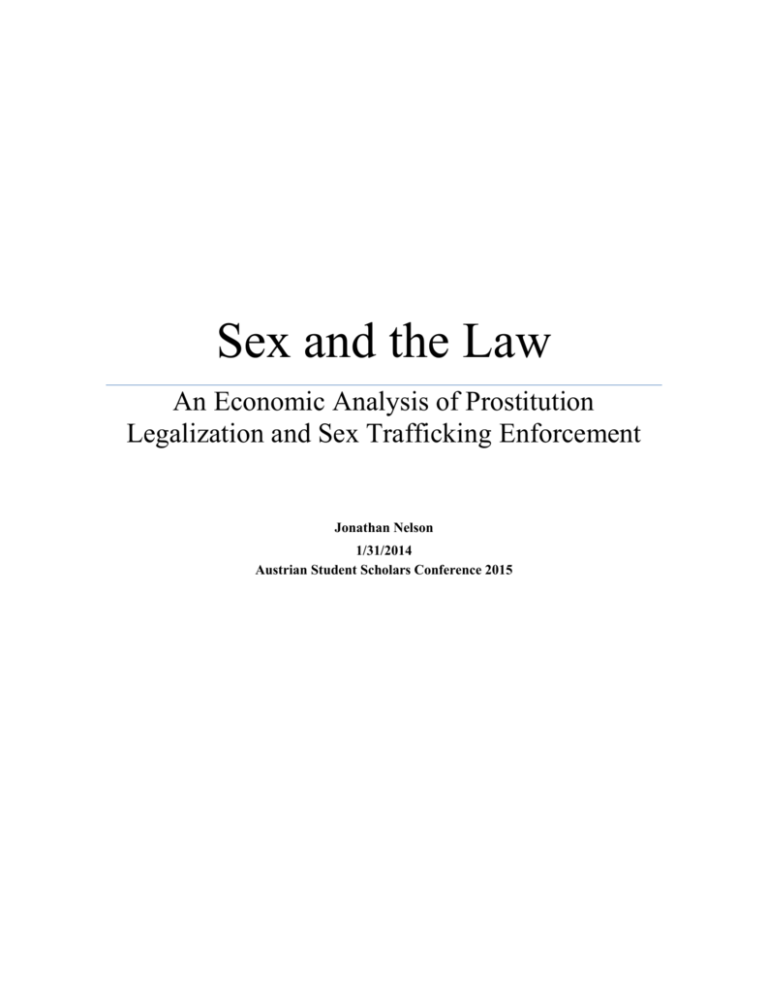
Sex and the Law
An Economic Analysis of Prostitution
Legalization and Sex Trafficking Enforcement
Jonathan Nelson
1/31/2014
Austrian Student Scholars Conference 2015
1
Introduction
One of the worst violations of human rights in history is happening right now.
Throughout the world, from Eastern Europe to Southeast Asia to even the United States,
people are being kidnapped from their homes and taken to faraway lands, sometimes in
another continent, to be sold as slaves. The most prominent form of modern human
slavery is forced sex labor, often referred to as sex trafficking or sex slavery. A 2004
study found that approximately 46 percent of all trafficked persons were being forced into
sex work (Aronowitz, 2009, p. 35). In many countries, all forms of sex work are illegal,
whether they are in the form of slavery or voluntary. In fact, historically there has been
no distinction between prostitution and sex trafficking (Ditmore, 2005, p. 108). Even
today, many anti-prostitution advocates equate prostitution with sex trafficking. The
market for voluntary prostitution and sex trafficking are clearly connected in many ways.
Whether legal or illegal, the demand for sex services certainly affects the market for sex
trafficking; without the demand for sex, there is no demand for sex slavery. If prostitution
is legalized, this is certain to have an effect on sex trafficking and exploitation. After
examining the economics of human trafficking and voluntary prostitution, as well as
empirical and real-life case studies, we find that in most cases, legalization of prostitution
leads to an increase in human trafficking. However, it is possible that with the correct
legal and regulatory structures in place, the benefits of legalization can outweigh the
possible negative consequences.
2
The Case for Legalization
Why would anyone want to legalize prostitution? What are the benefits to
legalizing something that had long been considered too immoral and degrading to
consider? The first main argument for the legalization of prostitution is based in
libertarian ethical theory. Prostitution, when practiced in a voluntary framework, is a
victimless activity. As long as both parties consent to the interaction, buying and selling
sex is no different than buying or selling any other good or service. In voluntary
exchange, both parties benefit. Economist Walter Block (1976) defends the work of the
prostitute; as long as it is voluntary, the prostitute should have the right to earn a living
just like any other worker. He even points out that all forms of sexual congress are, in
some way, an exchange. Married or dating couples who are sexually active do not engage
in such activity for free. Although there may not be an emotionally-detached cash transfer
between the two parties, the couple likely engages in some kinds of physical or emotional
exchanges1 (p. 3-7). As George Carlin said, “Sex is legal. Selling is legal. Why is selling
sex illegal?”
The second main argument for legalization is based in economics. Like any other
governmental prohibition, the criminalization of prostitution carries many unintended
secondary economic effects with it. The prohibition of any good or service does not
eradicate it from the market; it simply forces it underground into the black market. In the
black market, the good or service (i.e. sex work) is necessarily more dangerous than in a
legal framework because neither workers nor clients can legally protect themselves from
1
For example: physical gifts, dates, or emotional sentiments, all of which are reciprocal in some ways.
3
violence or fraud. For example, if prostitution is illegal, a sex worker cannot go to the
police if a client refuses to pay after the sexual services, or even worse, commits violence
against her during the act. The illicit sex industry then must resort to a system of pimping
to “protect” women from fraud and violence. However, the very pimps who are meant to
protect the prostitutes from violence can be abusive against the women themselves, often
resorting to violence enforce their will upon the sex workers. Legalized prostitution can
protect workers by prohibiting this kind of exploitation from coercive third parties, and
allow mutually beneficial third parties to emerge, such as managers and brothel owners.
Weitzer (2011) outlines several specific consequences of the criminalization of
sex work. First, arrests of sex workers have a minimal deterrent effect. Most women
return to selling sex shortly afterwards, partially because they feel they have no other
choice. Their arrest only serves to give them a criminal record, making it more difficult to
find more legitimate work. Second, most prostitution poses little to no harm to the public,
as most sexual exchanges occur in discreet and private settings. Third, prostitution
criminalization is costly to the justice system. Lastly, criminalization makes it less likely
for sex workers to report victimization to the police. They may fear arrest for their
criminal activities or that the police will not take their concerns seriously2 (p. 49).
Weitzer and others believe that the legalization of prostitution would alleviate most of
these problems. However, it is possible that in the fixing of these problems, the
legalization of prostitution would allow sex trafficking to flourish. The next section will
2
American police have a history of discounting the claims of prostitutes, seeing them as deserving of their
fate or exploiting them for sex in lieu of arrest. See Weitzer (2011, p. 49).
4
discuss the economic theory of both involuntary and voluntary sex services in an attempt
to address and answer this concern.
Economics of Sex Slavery vs. Economics of Voluntary Sex
Services
To fully theorize how the legalization of prostitution would affect sex trafficking
and sex slavery, we must examine and compare the economics of sex trafficking and
slavery with the economics of voluntary sex services. Kara (2009) outlines various
factors influencing both the supply and the demand for sex trafficking and slavery.
Supply of sex slaves is high for three main reasons. First, throughout the world, there are
impoverished and disenfranchised persons who are desperate to find a better life. They
may be willing to do almost anything to make their lives better and they are vulnerable to
being coerced or tricked into the sex slave trade. Second, economic globalization and free
trade has made it cheaper and easier for sex traffickers to procure and transport sex
slaves. In many countries, it is easier than ever to move persons across borders, especially
if they have permits to work. While this is a good thing for those who voluntarily choose
to seek better lives in other countries, this does make it easier for human traffickers to
move slaves around the world. Third, in many parts of the world, women (especially
foreigners or minorities) those are legally discriminated against. They are denied rights
and in some countries even systemically treated as male sexual property. It should not be
surprising then that the most active sex trafficking originates in these regions (p. 23-32).
Kara identifies several different ways that sex slaves may be forced into slavery.
Many sex slaves fall for deceit by traffickers, often in the form of the false offer of a job
5
or travel, or even false marriage offers. These offers are enticing, especially to the poor
and disenfranchised who are desperate for a better life. Tragically, some sex slaves are
sold into slavery by their own families, who are often desperate for additional income.3
Although made famous by movies such as Taken, abductions are a much less frequent
means of acquiring sex slaves because it is much more difficult and costly. Some sex
slaves fall victim to false promises of love; they migrate to another country voluntarily,
but are forced into slavery upon arrival (p. 7-10).
In order for sex trafficking to thrive, there must be a high demand for trafficking
to accompany the high supply of sex slaves. Part of the high amount of demand comes
from the highly price-elastic nature of the demand for sex services. As the supply of sex
workers and slaves rises, the price of sex services decreases. This decrease price leads to
a sharp increase in the quantity demanded of these services (p. 37). Evidence for the high
income-elasticity of the demand for sex services was found in the U.K during the recent
recession. The quantity demanded of sex services decreased sharply as people had to
spend their money on more vital goods. This resulted in an increase in competition
among sex workers, and the lowering of prices (The Economist, 2012).
Kara states that another reason that the demand for sex slaves is so high is that
“sex slavery is the profit-maximizing version of prostitution” (2009 p. 33). The argument
is that the owners of brothels can minimize their labor costs by having sex slaves as their
workers instead of having to pay wages to voluntary sex workers. As these profits
increase, the demand for sex slaves increases among these brothel owners. In this
3
Sadly, in some rare cases, parents simply sell their children out of greed.
6
analysis, however, Kara fails to expound upon the deeper economics behind the use of
slaves as a labor force.
In Human Action, Ludwig von Mises says that the slave owner—in this case the
owner of the sex slave-filled brothel—does not receive an economic profit from using
slaves instead of voluntary labor. Mises explains, “He who buys a slave must in the price
paid make good for these economies as far as they may be expected; he pays for them in
full, due allowance being made for time preference” (1949, p. 625). The slave owner
must pay the full sum of the discount marginal revenue products (DMRP) of the slaves.
Therefore, it is the slave “hunter,” not the owner who profits from slavery as an
institution. Mises says that slavery is not profitable in the long run because slaves tend to
be less productive and produce a lower quality product, and therefore cannot compete
with more productive voluntary labor.4
While this analysis may be sufficient and accurate for the case of manufacturing
and agricultural industries in the 18th and 19th centuries, Mises’ analysis of slavery may
not be complete in the context of modern sex trafficking. In a fully voluntary market, the
supply of sex workers would likely be fairly low, and thus the DMRP of the workers
would be fairly high. In a market with forced labor, however, the supply of sex workers
would be much greater as women are forced into the illicit sex industry. In other
industries, the supply of forced labor and voluntary labor are likely to be comparable; in
the sex industry, the supplies are more likely to differ greatly. This increase in supply will
4
An analysis of the economics of slavery would not be complete without at least mentioning Gordon
Tullock’s 1967 article “The Economics of Slavery.” However, his analysis in this work relevant to the topic
at hand is very similar to Mises’ in Human Action and will be implicitly addressed below.
7
lead to a decline in the DMRP of the sex workers. In this case, the sum of the DMRPs
may be much less than it would be in a voluntary framework. If the brothel-owned sex
slaves are viewed as assets, low DMRPs of the sex slaves means that brothel owners have
fairly low capital expenditures; they may be significantly low than the labor costs of
voluntary sex work, making sex slavery more profitable. The high price-elasticity of the
demand for sex services may also make sex slavery a more profitable form of
prostitution. As the price declines due to an increase in supply, the demand will increase
at a greater rate, increasing the total revenue of brothel owners.
Using this supply-demand analysis, we can theorize how the legalization of
prostitution would affect sex trafficking. The legalization of prostitution will expand the
sex services market, which is likely to include both voluntary and coerced labor. Some
workers will voluntarily enter the market now that prostitution has been legalized. Others
may be released from slavery if the correct legal mechanisms are in place to prevent
involuntary work. Both voluntary and involuntary labor from other nations may migrate
to the area where prostitution is legal. Overall, supply will probably increase. The
demand for sex services in general will likely increase as the risk of arrest for solicitation
disappears. Some consumers will actively seek out the new legal and voluntary workers,
taking away some of the demand for sex trafficking. Other consumers will not
differentiate between voluntary and coercive sex services, either because they simply
choose not to or because they cannot. If well managed by sex slave-owners, coercive sex
work may look a lot like voluntary sex work to the consumer. But overall, demand for
sex services will increase. If sex slavery is the profit-maximizing version of prostitution
8
as discussed above, brothel owners will likely engage in sex trafficking to take advantage
of the newly increased supply and demand. Thus, the demand for sex slaves will increase
along with the demand for sex services overall, and without the proper regulatory
mechanisms, supply may also increase. Therefore in theory, the legalization of
prostitution will generally lead to an increase in sex trafficking.
Empirical Studies
Cho et al. (2013) establish two theoretical constructs for how legalization would
affect the demand for human trafficking; each work in opposite directions. The scale
effect increases the amount of human trafficking by expanding the prostitution market.
As demand for sex work increases due to legalization, trafficking will increase to fill the
demand. The substitution effect, on the other hand, decreases the amount of trafficking by
displacing illicit prostitution with legal and regulated sex work. Cho et al. explain that
since these two theoretical effects cancel each other out, economic theory alone cannot
say how the legalization of prostitution would affect the amount human trafficking.
The economic theory is often too inconclusive to determine exactly how
prostitution legalization would affect sex trafficking. Economists often turn to empirical
studies to analyze the effects of specific policies on markets. There are a handful of
empirical academic studies that have attempted to answer the question of how the
legalization of prostitution in the real world has affected the demand for human
trafficking. To solve this dilemma, Cho et al. turn to empirical study. Their study
contained 150 countries, some who have legal prostitution and others who do not. “On
average, countries with legalized prostitution experience a larger degree of reported
9
human trafficking inflows” (p. 75). While the available statistics show this correlation,
Cho et al. admit that “the clandestine nature of both the prostitution and trafficking
markets, [make] it difficult, perhaps impossible, to find hard evidence establishing this
relationship” (p. 76). There statistics do show that there is likely at least a moderately
positive correlation between prostitution legalization and sex trafficking increases.
In similar paper, Jakobsson et al. (2013) develop a slightly different theoretical
structure, but come to essentially the same conclusions. They focus primarily on the scale
effect, which for them has two dimensions. The legal status of prostitution affects both
the demand for sex services and the stigma of buying and selling sex services. The
legalization of prostitution then increases the demand for sex services and may partially
remove the stigmatization of these services. After running the data, their results supported
their theory that “most trafficking [flows] to countries where prostitution is legal and
regulated, least in the countries where buying and/or selling sex is illegal, and flows in
between in countries where it is legal to buy and sell but illegal to profit as a third party
(pimps or brothel owners)” (p. 8). Like Cho et al. above, Jakobsson et al. found a positive
correlation between trafficking flows and legal prostitution.
We find that in general, both theoretically and empirically, the legalization of
prostitution leads to an increase in sex trafficking into the country. However, if a nation
decides to legalize prostitution, it can do so in many different ways; the way in which
legalization takes place may make a big difference. The legalization generally has to
conform to the already existing legal structures in place, so legalization in different
countries will have different results and different levels of effectiveness. The next section
10
will outline how legalization ideally should be done, and how it has actually been carried
out by several countries.
Legalization in Practice
Weitzer (2011) outlines certain provisions that the legalization of prostitution
would have to include to prevent the public being needlessly exposed to the sex industry
and to protect the sex workers from being victimized. He says that “consensual adult
prostitution [should] be officially recognized as work and that participants be accorded
the rights and protections available to those involved in other occupations” (p. 207).
Legal prostitution would have to minimize the visibility of the industry. This would keep
the industry out of public disfavor and prevent the dangerous practice of street
prostitution.5 Minors should be prohibited from participating in the sex industry, both
from selling or buying services. Sex workers should not be forced to register as
prostitutes since many will refuse to register to keep their work more secret. Healthy
practices should be encouraged, including outreach education for sex workers and
compulsory health examinations. Finally, and most importantly for our purposes here, the
rights of the workers must be protected. They must not be forced to service a client, and
they should be free from coercion or harassment (p. 211).
It is important to differentiate legalization from mere decriminalization. De jure
decriminalization would officially remove the criminality of prostitution from the actual
5
See chapter 2 of Weitzer (2011) for the differences between indoor and street prostitution. Indoor
prostitution tends to be much safer for several reasons. Indoor sex workers are less vulnerable to predators,
they are able to more easily screen clients, and there is more likely to be someone there to intervene if the
client becomes abusive.
11
law, but it would not put any regulatory mechanisms in place. De facto decriminalization
is arguably the worst form, since it is simply the nonenforcement of the law, which could
be arbitrarily used and easily abused. Neither form of decriminalization would contain the
provisions that Weitzer outlines above. In a free market society, all voluntary actions by
individuals would be “decriminalized,” not legalized in the sense of being regulated by a
government. But the market would self-regulate to an extent. Competition among
brothels and sex workers would likely encourage health and safety standards comparable
to those mandated by the government. Civil courts would protect the rights of all
involved, including the workers, the brothel-owners, and the clients. In the current legal
framework, however, in which the government crowds out private arbitration and certain
self-regulatory mechanisms, regulated legalization is probably a better model. The next
section will examine the ways in which four countries (Sweden, Netherlands, United
States, Spain) have actually implemented prostitution legalization or decriminalization
policies and analyze the effects of these policies and their enforcement.
Case Studies
Sweden has taken what could be considered a third way when it comes to the
legality of prostitution. In Sweden, prostitution was completely legal and regulated from
the 1970s until 1999. In 1999, the Swedish government made it illegal to buy, but not
sell, sexual services. The logic behind the law is that sex workers, who are seen as
exploited or desperate, should not be punished for selling sex, but the criminalization of
purchasing sexual services will still fulfill the purpose of decreasing the amount of
prostitution (and therefore decreasing the demand for sex trafficking) in the society. This
12
law prevents sex workers from being afraid to seek help if they are being victimized, all
without actually condoning prostitution itself. A government report by the Swedish
Institute (2010) found that after the law was passed in 1999, prostitution had decreased
throughout the nation. Street prostitution had decreased by half (p. 7); this is reasonably
contributed to the law causing buyers of sex to be more cautious, resulting in a decrease
in the demand for street prostitution. Ekberg (2004) says that this decrease in demand
leads to a decrease in the demand for sex trafficking as the industry becomes less
profitable, and traffickers will shift to more profitable destinations.
Despite these advantages of the Swedish model, the law may also have some
unintended economic consequences. Restricting the demand for sex services will, at least
in the short run, decrease the price for these services.6 Some may be willing to drop out of
the market, but some may see sex work as their best option. This decreases the incomes
of sex workers, making them worse off, not better. This decrease in legal demand may
also create an incentive for sex workers to protect their clients from prosecution since
they don’t want to lose their business if they are arrested. This may cause the prostitutes
to be less safe, and may even leave them more vulnerable to sex trafficking. If we accept
that prostitution must be criminalized to prevent sex trafficking, the Swedish model
seems to be the best.7 However, there may be better options.
6
This was seen in the sex industry in the UK, which saw significant decreases in prices after demand fell
during the recession, due primarily to the highly elastic nature of the demand for sex services (The
Economist 2013).
7
Kara (2009) is skeptical of prostitution criminalization being effective because of corruption, but
ultimately advocates for criminalization as practiced by the U.S. and Swedish governments as the best
defense against sex trafficking (p. 105).
13
In Amsterdam, prostitution has been tolerated for over 500 years, but the ban on
brothels in the city was only lifted in 2000. The legalization of brothel-based prostitution
included various provisions to protect sex workers working in the city. It is illegal to
force an adult into prostitution or profit from a coerced adult’s sex work. Minors are
prohibited from working in the industry; the minors themselves are not punished, but
clients of prostitutes under the age of 18 are liable to punishment (Weitzer, 2011, p. 149).
Possibly due to legalization making sex trafficking enforcement more effective, in 2005,
the Netherlands received high marks in the Trafficking in Persons Report (Feingold,
2005, p. 28). A Dutch government report (Daalder 2007) also reported that sex trafficking
has decreased, but it admitted that involuntary sex work is hard to detect. Kara (2009)
says that local experts claim that despite the statistics, trafficking has actually increased
since legalization due to a lack of enforcement and bribery. But even if this is true, it is a
product of poor execution of the law, not the result of legalization itself.
In the United States, prostitution legislation is largely left up to the states. In most
states, prostitution is illegal, and the Federal government prohibits the interstate
transportation of sex workers. The laws are enforced fairly strictly. In the year 2009, over
60,000 Americans were arrested for violating prostitution laws (Weitzer, 2011, p. 48).
The official stance of the U.S. government is that “where prostitution has been legalized
or tolerated, there is an increase in the demand for sex slaves and the number of
victimized foreign women—many likely victims of human trafficking” (U.S. Department
of State, 2004).
14
Despite the official stance by the Federal government, brothels are legal in
Nevada, and they provide an interesting and helpful case study for how prostitution can
be practiced legally and with fairly small amounts of exploitation. A majority of the
workers in the legal brothels are independent contractors (Brents et al, 2010, p. 131).
Most brothels in the suburbs allow sex workers to leave the brothels after their shifts are
over (p. 133). Workers are allowed to come and go from brothel-to-brothel. If they feel
they are mistreated or don’t like working at one, they are generally allowed to leave and
go to another. This market mechanism serves to self-regulate the sex service industry in
Nevada. As the market has expanded, competition has made the industry safer for the
workers and clients alike. Brents et al. conclude that the Nevada model is superior to
criminalization. Its provisions allow for the sex work to be carried out in a safe and fairly
discrete manner, and the “structures in place have successfully prevented violence,
disease, and sever exploitation” including trafficking (p. 233). As with other examples,
what the law says and what is actually practiced can be different. Some brothel owners do
violate the rights of their workers without being subject to prosecution. However, this
problem is solved with better enforcement of the law, not criminalization.
An example of poor legalization is modern Spain. Prostitution is legal, but is not
regulated, which means that sex workers are not protected. They are not considered
“workers” in the legal sense, and thus fail to have the same legal protections as other
legitimate professions. This leads to violence against and exploitation of many of those
who are work voluntarily, and also allows sex slavery to flourish. There is no regulatory
mechanism to identify and prevent sexual exploitation. Unsurprisingly then, Spain has
15
experienced an influx of sex slaves into the country. Pimping is also illegal in Spain,
which in this situation, makes the sex workers even more vulnerable to violence and other
forms of victimization (Daley, 2012).
From these examples, we see that the legalization of prostitution can have some
benefits. It provides better protection for the sex workers and respects the subjective
preferences of both workers and clients. If legalization is carried about in an effective
manner and regulations regarding workers’ rights are strictly enforced, the benefits can be
reaped without the possible negative consequences. However, if done poorly, legalization
can greatly increase sex trafficking and lead to the further victimization and sexual
exploitation of the workers.
Conclusion
After examining the economic theory behind both sex trafficking and slavery and
voluntary sex work, we found that the effects of prostitution legalization are unclear and
specific to situations. Looking at empirical studies, legalization tends to increase sex
trafficking flows in countries that have legal prostitution.8 Further, we studied real-life
case of prostitution legalization, and we found that in certain cases in which proper legal
and regulatory mechanisms are in place, legalization can be done while minimizing sex
trafficking and exploitation.
8
The reason that countries with legal prostitution tend to have greater inflows of sex trafficking may be
because these countries lack the proper legal mechanisms to fight trafficking, not because legal prostitution
causes increases in trafficking. Countries with more developed legal systems such as the United States tend
to either criminalize or decriminalize (but not legalize) prostitution. This could be further explored in a
future paper.
16
Works Cited
Aronowitz, Alexis A. 2009. Human Trafficking, Human Misery. West Port: Praeger.
Block, Walter. 1976. Defending the Undefendable. New York: Fleet Press.
Brents, Barbara, Crystal Jackson, and Kathryn Hausbeck. 2010. The State of Sex:
Tourism, Sex, and Sin in the New American Heartland. New York: Routledge.
Cho, Seo-Young, Axel Dreher, and Eric Neumayer. 2013. "Does Legalized Prostitution
Increase Human Trafficking?" World Development 41: 67-82.
Daalder, A.L. 2007. “Prostitution in the Netherlands since the Lifting of the Brothel
Ban.” Wetenschappelijk Onderzocken Documentatiecentrum.
Daley, Suzanne. 2012. "In Spain, Women Enslaved by a Boom in Brothel Tourism." The
New York Times. http://www.nytimes.com/2012/04/07/world/europe/youngmen-flock-to-spain-for-sex-with-trafficked-prostitutes.html.
The Economist. 2013. "Sex Doesn't Sell." The Economist.
http://www.economist.com/news/britain/21578434-old-industry-deep-recessionsex-doesnt-sell.
Ekberg, Gunilla. 2004. “The Swedish Law that Prohibits the Purchase of Sexual Services:
Best Practices for Prevention of Prostitution and Trafficking in Human Beings.”
Violence Against Women 10, no. 10: 1187-1218.
Eurostat. 2014. “Trafficking in human beings.” Eurostat Statistical Working Papers.
Feingold, David A. 2005. “Human Trafficking.” Foreign Policy, no. 150: 26-30, 32.
Jakobsson, Niklas and Andreas Kotsadam. Revised 2013. “The Law and Economics of
International Sex Slavery: Prostitution Laws and Trafficking for Sexual
17
Exploitation.” University of Gothenburg.
Kara, Siddharth. 2009. Sex Trafficking: Inside the Business of Modern Slavery. New
York: Columbia University Press.
Mises, Ludwig von. 1949. Human Action: A Treatise on Economics. New Haven: Yale
University Press.
Swedish Institute. 2010. “The Ban against the Purchase of Sexual Services. An evaluation
1999-2008.” http://www.government.se/content/1/c6/15/14/88/0e51eb7f.pdf.
Tullock, Gordon. 1967. “The Economics of Slavery.” Left & Right: A Journal of
Libertarian Thought 3, no. 2: 5-16.
U.S. Department of State. 2004. “The Link Between Prostitution and Sex Trafficking.”
University of Nebraska-Lincoln.
Weitzer, Ronald John. 2011. Legalizing Prostitution: From Illicit Vice to Lawful
Business. New York: NYU Press.

